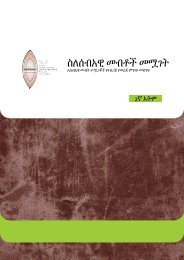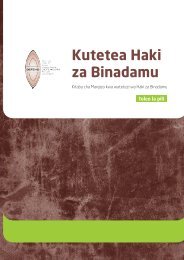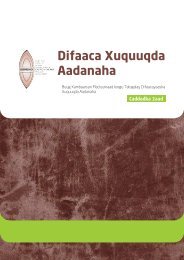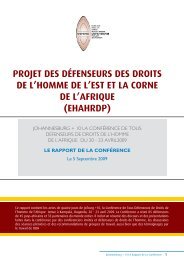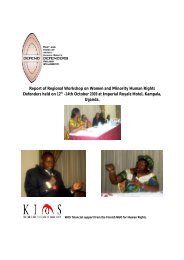English PDF - East and Horn of Africa Human Rights Defenders ...
English PDF - East and Horn of Africa Human Rights Defenders ...
English PDF - East and Horn of Africa Human Rights Defenders ...
You also want an ePaper? Increase the reach of your titles
YUMPU automatically turns print PDFs into web optimized ePapers that Google loves.
Conference Report: Resources <strong>and</strong> Proceedings 7The remaining seven newspapers; Setit, Mekalih, Kestedebena, Tsigienay, Hadas Admas, Zemen,<strong>and</strong> Wintana, which survived the market competition continued to be printed twice a week with acirculation <strong>of</strong> 20,000 to 40,000 copies. They used to run their work under harsh conditions.Intimidation <strong>and</strong> telephone threats were part <strong>of</strong> their daily experience. Whenever the newspaperspublished content critical <strong>of</strong> the Government, the <strong>of</strong>ficials intimidated the editors via telephone. Itwas very common for journalists to be summoned to the police station for interrogation. TheGovernment had no tolerance whatsoever for any criticism launched by the independent press.However, the Government was not able to halt the momentum <strong>of</strong> the independent press. Theindependent newspapers intensified their criticism. After Eritrea <strong>and</strong> Ethiopia agreed to settletheir border conflict peacefully, the conflict which began in 1998 <strong>and</strong> continued till the end <strong>of</strong>2000. They advised <strong>and</strong> reminded the Government to respect the rights <strong>of</strong> citizens. They calledfor the rule <strong>of</strong> law <strong>and</strong> implementation <strong>of</strong> the constitution. They educated the people <strong>of</strong> theirrights <strong>and</strong> duties <strong>and</strong> exposed how the Government worked. They became the voice <strong>of</strong> the peopleby echoing their pain <strong>and</strong> concerns.At the same time, the Eritrean power circles were set back by the uncontrollable drive <strong>of</strong> the freepress. All sorts <strong>of</strong> harassment intended to block the development <strong>of</strong> the free press began to showup. One <strong>of</strong> the frequently used measures was the forceful <strong>and</strong> unjustifiable conscription <strong>of</strong> theindependent journalists into national service or, at times, outright arrests <strong>of</strong> some <strong>of</strong> them,summoning them to the police station for interrogation. These were common experiences <strong>of</strong> mostindependent journalists. There was also a period <strong>of</strong> <strong>of</strong>ficial censorship before publication.The first wave <strong>of</strong> Government crackdown on the independent press took place in October 2000when eight journalists were arrested. However, the Government didn’t dare to keep themimprisoned for long because the pressure from the international community was strong. Theywere released a week later.When higher <strong>of</strong>ficials <strong>of</strong> the Eritrean Government, known as the G15, criticized the President intheir open letter <strong>of</strong> May 2001, the independent press entertained ideas <strong>of</strong> dissent in their columns,which became a nightmare for the Government. President Isaias Afwerki’s regime started toattack aggressively all fundamental freedoms <strong>of</strong> the country in September 2001 by exploiting theincident <strong>of</strong> bombing <strong>of</strong> the World Trade Center. He arrested eleven former leaders <strong>of</strong> theGovernment <strong>and</strong> banned all private press on September 18, 2001, while the attention <strong>of</strong> theinternational community was switched to the USA.This was immediately followed by the second wave <strong>of</strong> ‘group arrests’ <strong>of</strong> independent journalists.Fourteen journalists from the private <strong>and</strong> State media were arrested <strong>and</strong> held incommunicado.Amanuel Asrat, Editor-in-Chief <strong>of</strong> Zemen; Matios Habteab, Editor-in-Chief <strong>of</strong> Mekalih; YosufMohamed Ali, Editor-in-Chief <strong>of</strong> Tsigienay; Said Abdelkadir, Editor-in-Chief <strong>of</strong> Hadas Admas;Dawit Habtemichael, assistant Editor-in-Chief <strong>of</strong> Mekalih; Medhanie Haile, Assistant Editor-in-Chief <strong>of</strong> Kestedebena; Dawit Isak, reporter for Setit; Fissehaye Yohannes (Joshua) reporter forSetit <strong>and</strong> winner <strong>of</strong> the International Press Freedom Award <strong>of</strong> CPJ; Temesgen Gebreyesus,reporter for Kestedebena; Seyoum Tsehaye, freelance editor/photographer <strong>and</strong> former director <strong>of</strong>Eritrean state television; Fitsum (Wedi Adie), reporter for Zemen; Ghebrehiwet Keleta, reporterfor Tsigienay; Salih Aljezaeeri, reporter for the Government radio (Dimtsi Hafash); <strong>and</strong> HamidMohamed Said, reporter for the Government TV (Eri-TV). This is what made Eritrea, in CPJ’swords: “Journalists’ largest prison in <strong>Africa</strong>”.On March 31, 2002 the journalists <strong>of</strong> the private press, who were vegetating in the prisons, wenton a hunger strike in protest <strong>of</strong> their prolonged detention without any due process <strong>of</strong> law. Threedays later, on April 3, 2002, they were forcibly taken into an undisclosed location <strong>and</strong> have since



